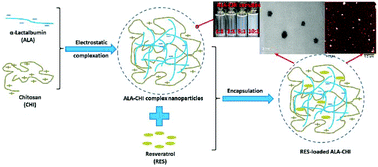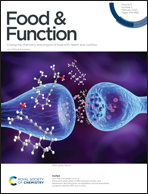α-Lactalbumin and chitosan core–shell nanoparticles: resveratrol loading, protection, and antioxidant activity
Abstract
Resveratrol (RES)-loaded protein–polysaccharide nanoparticles were fabricated through simple electrostatic interactions with oppositely charged α-lactalbumin (ALA) and chitosan (CHI) with a mass ratio of 5 : 1 without the addition of NaCl at pH 6.5. The Z-average diameter and zeta-potential values of RES–ALA–CHI nanoparticles were 211.0 nm and 13.23 mV, respectively. Both TEM and AFM graphs confirmed that RES–ALA–CHI nanoparticles had a spherical shape, and were dispersed homogeneously at the nanoscale. The encapsulation efficiency (EE) and loading amount (LA) of RES in RES–ALA–CHI nanoparticles were 58.86% and 196.2 μg mg−1, respectively, in the presence of 400 μg mL−1 RES. XRD results confirmed that RES was in amorphous form in ALA–CHI nanoparticles. The interaction between RES and ALA–CHI nanoparticles was mainly driven by hydrophobic interaction and hydrogen bonding. Compared to RES (free), the UV light and heat stability, in vitro bioaccessibility, and antioxidant activity of RES in RES–ALA–CHI nanoparticles were pronouncedly enhanced. The information provided in this study should be of interest to the food industry to fabricate robust nanoscale delivery systems with ALA–CHI nanoparticles for RES and other hydrophobic bioactive compounds.



 Please wait while we load your content...
Please wait while we load your content...